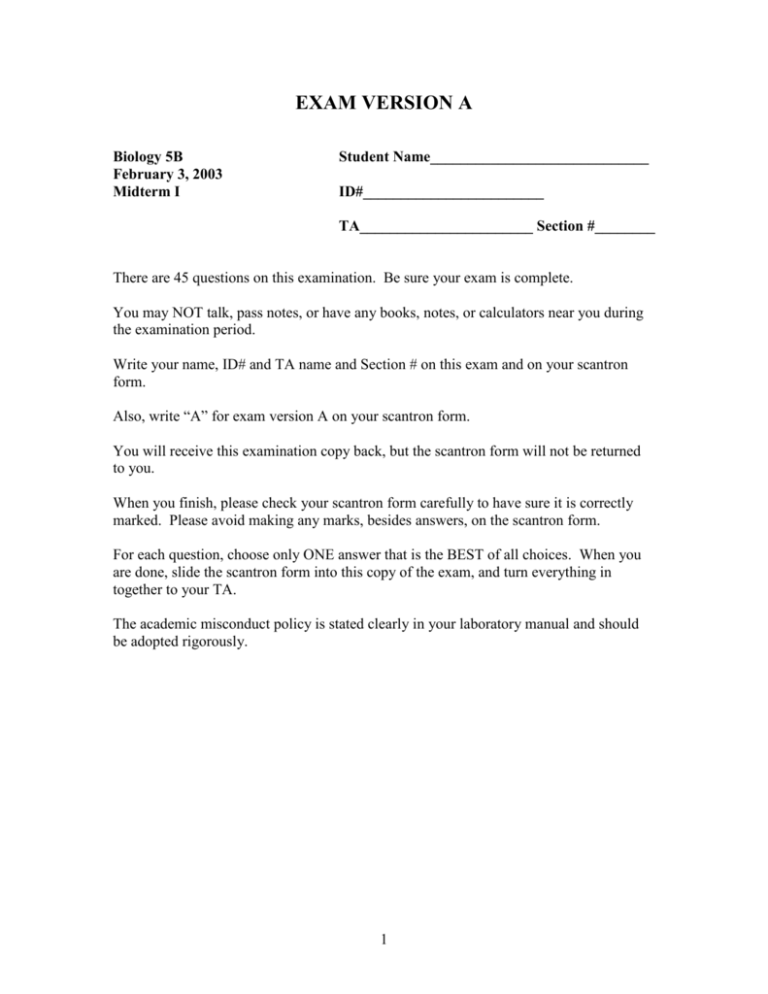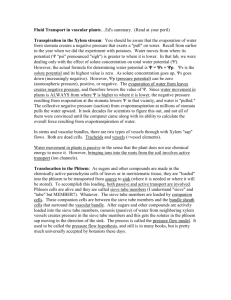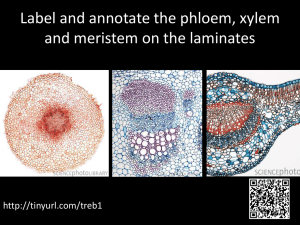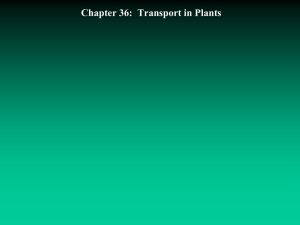Bio 5B Midterm I
advertisement

EXAM VERSION A Biology 5B February 3, 2003 Midterm I Student Name_____________________________ ID#________________________ TA_______________________ Section #________ There are 45 questions on this examination. Be sure your exam is complete. You may NOT talk, pass notes, or have any books, notes, or calculators near you during the examination period. Write your name, ID# and TA name and Section # on this exam and on your scantron form. Also, write “A” for exam version A on your scantron form. You will receive this examination copy back, but the scantron form will not be returned to you. When you finish, please check your scantron form carefully to have sure it is correctly marked. Please avoid making any marks, besides answers, on the scantron form. For each question, choose only ONE answer that is the BEST of all choices. When you are done, slide the scantron form into this copy of the exam, and turn everything in together to your TA. The academic misconduct policy is stated clearly in your laboratory manual and should be adopted rigorously. 1 1. Eukaryotic and prokaryotic flagella can best be described as: a. Homologous structures d. Anomalous structures b. Homophonic structures e. None of the above c. Analogous structures 2. Which of the following proteins would you not expect to find in a protist? a. Tubulin d. Kinesin b. Actin e. Flagellin c. Dynein 3. Movement of a Paramecium and movement of mucus by sheets of epithelial cells in metazoans is performed by ___________ that beat in a ________________ fashion. a. Cilia, synchronal d. Flagella, metachronal b. Cilia, metachronal e. Microfilaments, peristaltic c. Flagella, synchronal 4. Relationships between organisms can be established by looking at and comparing a. Behavioral traits d. Genes and proteins b. Morphological characters e. All of the above c. Developmental patterns Distance Traveled The following diagram is for questions 5 and 6: A molecule of glucose diffuses through solution. D A B E C time 5. Which of the graphs describes the root mean square distance traveled by a glucose molecule as a function of time? 2 6. If the molecule of glucose diffuses a root mean square distance of 10 m in 1 second, how long will it take to move 100 m? a. 1/10 sec d. 100 sec b. 10 sec e. 1000 sec c. 10 sec 7. The scientist who is credited with observing developmental stages of different organisms to establish phylogenetic relationships between taxa was: a. Darwin d. Linnaeus b. Haekel e. Mendel c. Reznick 8. You find a fossil from a marine protist that had a multi-chambered porous shell made of calcium carbonate. This protist was most likely a: a. Rhizopod d. Cililiophoran b. Heliozoan e. Microsporan c. Foraminiferan 9. Which of the following locomote using pseudopodia: a. Rhizopoda b. Actinopoda c. Foraminifera d. a and b only e. a, b, and c 10. In what ways are all protists alike? They are all a. unicellular. d. free-living. b. photosynthetic. e. eukaryotic. c. marine. 11. The following statements about the dinoflagellates are true except: a. They possess two flagella. b. Some cause red tides. c. They are typically unicellular. d. Their fossil remains form limestone deposits. e. Many species have chlorophyll. 12. The largest (in terms of size) plant-like protists belong to which group? a. Cyanobacteria d. Chlorophyta (green algae) b. Rhodophyta (red algae) e. euglenozoa c. Phaeophyta (brown algae) 13. Which of the following do all fungi have in common? a. coenocytic hyphae d. symbioses with algae b. heterotrophic nutrition e. symbioses with plants c. sexual life cycle 3 Questions 14-16 refer to the following phyla. (Hint: each group is used no more than once). a. Ascomycota d. Zygomycota b. Basidiomycota e. Yeasts c. Chytridiomycota 14. This phylum consists of aquatic, coenocytic species that are saprophytes or parasites. 15. This phylum possesses gilled fruiting bodies and is commonly called the club fungi. 16. The spore-bearing structures of species in this phylum are called asci. 17. The fiber cells in plants belong to which tissue/tissues? a. Phloem d. sclerenchyma b. Xylem e. a., b. and d. are all possible. c. parenchyma 18. ____________ is to xylem as the sieve tube member is to _______________. a. Phloem; secondary xylem d. Vessel member; phloem b. Tracheid; wood e. Vessel; vessel member c. Procambium; vascular cambium 19. The major function of guard cells is: a. protection against pathogen infection. b. regulation of water loss. c. regulation of gas exchange. d. photosynthesis. e. Both b. and c. 20. Which of the following cell types is not present in vascular tissues of plants? a. parenchyma d. sieve tube members b. fibers e. collenchyma c. tracheids 21. The Casparian strip is a. a polymer that strengthens the secondary walls of tracheids and vessel members. b. a phenolic compound in mosses that protects them from harmful solar radiation. c. a water impermeable layer within the walls of endodermal cells that blocks transport through the apoplast into the xylem of roots. d. the waxy component of leaf epidermal cells that reduces water loss by transpiration. e. a zone of root hairs where most water and mineral ions are absorbed. 22. Root hairs are tubular extensions of root epidermal cells, which possess tip growth. These cells maintain a narrow shape because a. microtubules run predominantly lengthwise within them. b. actin microfibrils run predominantly lengthwise within them. c. microtubules run predominantly perpendicular to the long axis. 4 d. cellulose microfibrils run predominantly perpendicular to the long axis. e. Both c. and d. are true. 23. What cellular structure determines the sites of the metaphase plate and cytokinesis in dividing plant cells? a. position of the preprophase, interphase nucleus b. length to width ratio of the cell c. position of the centrioles d. the preprophase band e. the phragmoplast 24. A water molecule could move all the way through a plant from soil to root to leaf to air and pass through a living cell only once. This living cell would be a a. root hair. d. leaf epidermal cell. b. root epidermal cell. e. guard cell. c. root endodermal cell. 25. In which plant cell or tissue would the pressure component of water potential most often be negative? a. leaf epidermal cell d. stem xylem b. leaf mesophyll cell e. endodermal cell c. stem phloem 26. What provides the energy for most water transport upwards in the xylem? a. ATP d. solar radiation b. sucrose e. root pressure c. proton gradients 27. What provides the energy for transport through the phloem? a. ATP d. all of the above b. sucrose e. only a. and c. c. proton gradients 28. Water flows into the source end of a sieve tube because a. sucrose has diffused into the sieve tube, making it hypertonic. b. sucrose has been actively transported into the sieve tube, making it hypertonic. c. water pressure outside the sieve tube is higher than inside. d. water potential of the sieve tube is higher than that of the surrounding cells. e. sucrose has been dumped out of the sieve tube by active transport. 29. Organic molecules make up approximately what percentage of the dry weight of a plant? a. < 10% d. 80% or less b. approximately 20% e. >90% c. approximately 2/3s 5 30. What is the mutualistic symbiosis between roots and fungi called? a. root nodules d. mycorrhizae b. Rhizobium infections e. haustoria c. parasitism 31. A mineral deficiency is likely to affect older leaves more than younger leaves if a. The mineral is a micronutrient. d. The deficiency persists for a long time. b. The mineral is mobile in the plant. e. The older leaves are in the shade. c. The mineral is required for growth. 32. Micronutrients are needed in very small amounts because a. Most of them are mobile in the plant. b. Most are present in large enough quantities in the seed. c. Most function as cofactors in enzyme reactions. d. Most play only a minor role in plant health. e. Most are needed only in growing regions of the plant. 33. We know from the experiments of the past that plants bend toward light because a. They need sunlight energy for photosynthesis. b. The sun stimulates stem growth. c. Cell expansion is greater on the dark side of the stem. d. Auxin is more active on the light side of the stem. e. Phytochrome inhibits stem growth on the light side of the stem. 34. Plant hormones can be characterized by all of the following statements except a. They may act by altering gene expression. b. They have a multiplicity of effects. c. They can control aspects of plant growth and development. d. They can control aspects of physiology. e. They are typically associated with a specific, unique response. 35. Plant hormones have different effects at different concentrations. This is why a. some plants are long-day plants and some are short-day plants. b. signal transduction pathways in plant cells are different from those of animal cells. c. they don’t really fit the definition of “hormone”. d. some plants grow toward light and some grow away from it. e. 2,4-D is used as a herbicide. 36. What do the results of research on gravitropic responses of roots and stems show? a. Different organs may show the same response to environmental stimuli. b. The effect of a plant hormone can depend on tissue or organ. c. Some responses of plants require no hormones at all. d. Light is required for the response in stems. e. The response to a hormone may depend more on the ratios of two or more hormones than on the actual amount of any individual hormone. 6 37. If a plant is mechanically stimulated, it will grow shorter, thicker stems than one that is not. This response is a. the result of excess ethylene production. b. caused by increased turgor pressure in the stem cells. c. an adaptation to windy environments. d. Only a. and c. are correct. e. a., b., and c. are correct. 38. Bryophytes have all of the following characteristics except a. multicellarity d. archegonia and antheridia b. specialized cell types e. a reduced, dependent sporophyte c. lignified vascular tissues 39. One of the major distinctions between plants and green algae is that a. only green algae have flagellated, swimming sperm. b. embryos are not retained on parental tissues in green algae. c. meiosis is faster in green algae than in plants. d. chlorophyll pigments in the green algae are different from those in plants. e. only plants have a phragmoplast during cytokinesis. 40. Two small, poorly drained lakes lie close to each other in a boreal forest. The basins of both lakes are composed of the same geologic substrata. One lake is surrounded by a dense Sphagnum mat: the other is not. Compared with the lake without Sphagnum, the lake surrounded by the moss should have a. a lower pH. d. only b. and c. are correct. b. lower numbers of bacteria. e. a., b, and c. are correct. c. reduced rates of decomposition. 41. A botanist discovers a new species of plant in a tropical rain forest. After observing its anatomy and cell structure, the following characteristics are noted: flagellated sperm, no lignified cells, and sporophyte dependent on the gametophyte. In addition, hydroids, leptoids and guard cells are present. This plant is most closely related to a. green algae d. mosses b. liverworts e. ferns c. hornworts 42. On the same collecting trip, this same botanist discovers another new species of plant. This plant’s features are: flagellated sperm, xylem with tracheids, separate and independent sporophyte and gametophyte phases, reproduction by spores. This plant is probably most closely related to d. green algae d. mosses e. liverworts e. ferns f. hornworts 7 43. The immediate products of meiosis in plants is always a. spores. d. seeds. b. sperms. e. eggs and sperm. c. eggs. 44. The leptosporangia of ferns are homologous to which of the following structures? a. spores of bryophytes d. protonemata of moss gametophytes b. capsules of moss sporophytes e. cones of horsetails c. gametangia of hornwort gametophytes 45. You observed the swimming sperm of an aquatic fern called Marsilea in the laboratory last week. This species is heterosporous because it produces a. a gametophyte that bears both antheridia and archegonia b. microspores and megaspores, which give rise to separate male and female gametophytes c. endosporic gametophytes d. Only b. and c. are true e. a., b. and c. are true. 8









